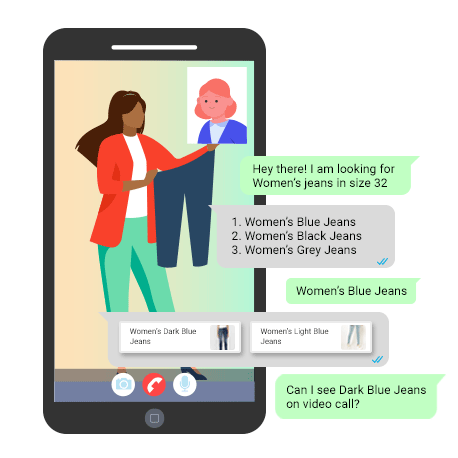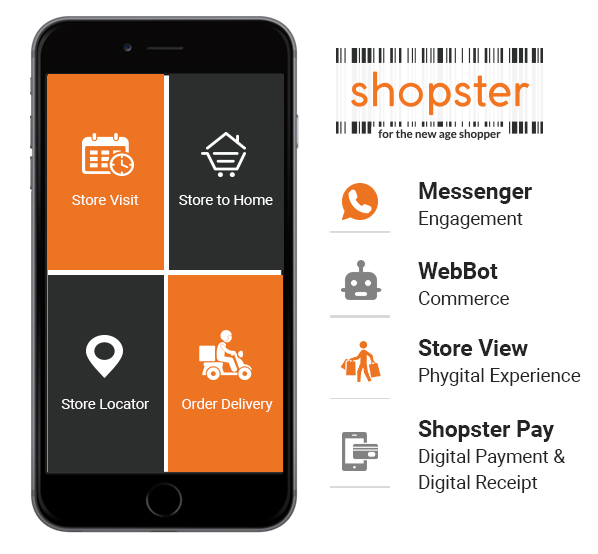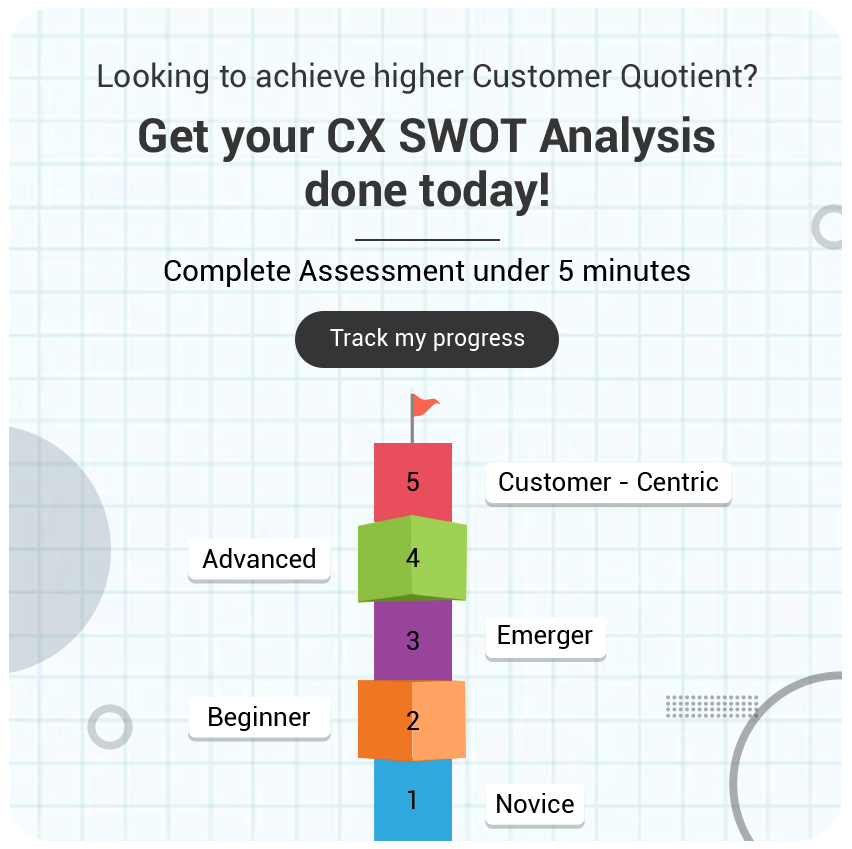CONVERSATIONAL COMMERCE
THE FUTURE OF RETAIL MARKETING
Shopping today is more about tailoring a `wow’ experience than just buying merchandise. Digital transformation journeys have become imperative for brands to create such intimate experiences. Rather than nudging consumers towards the brands, retailers are moving to platforms where their buyers reside – and today’s users reside on conversational platforms.
According to Statista, WhatsApp and Facebook Messenger have an active monthly user base of more than one billion people – which means a whopping one in every seven people in the world uses these social interaction tools.
Conversations lie at the core of commerce. Today, they have become automated – with retailers using conversational commerce tools that leverage AI-driven interactions to communicate with customers and lead them to a purchase. These digitized customer engagements happen via web-based chatbots, live chats, video interactions, or AI-powered virtual assistants.
Conversational tools allow brands to digitize and personalize in-store shopping experiences, and turn a shopper’s journey into a conversation, rather than a one-sided marketing monologue.
The pandemic proved to be a decisive turning point for conversational tools, as it pushed retailers to pursue digital transformation. With phygital (physical + digital) store models gaining traction, these cloud-based, plug-and-play technologies are emerging as the new way to shop, by providing personalized, real-time, one-on-one shopping experiences to consumers in their homes.
In this blog, we will look at how conversational commerce is impacting the retail industry, how it works, the big opportunity that it offers to brands, and future trends.
What is Conversational Commerce?
Premium retail stores were hit hard during the pandemic-triggered lockdowns. As these stores relied on walk-in customers to drive sales, the global lockdowns resulted in crippling business closures. However, digital customer engagement tools emerged as game-changers for the retail sector, as they enabled brands to go phygital, getting shoppers back to the stores, via virtual shopping experiences.
By deploying conversational toolkits – that use WhatsApp-driven engagement, WebBots, and AI-driven personalized recommendations – retail stores can create unique, appointment-based, safe, and dedicated shopping spaces, and engage meaningfully with their customers. They also make online shopping more interactive, less tiresome, and super safe.
Conversational toolkits are a powerful marketing medium that make automated interactions between a business and a customer feel human, as they offer real store shopping encounters, quick services, personalized attention, and seamless payment support. It’s opening new doors for retailers, as it enables them to reach users with smarter and more predictive experiences.
Retailers that get conversational commerce right see reduced customer churn and customer service costs. On the flipside, not creating this capability can make retailers look slow, inflexible, and impersonal.
Conversational Commerce brings the power of human interactions to Phygital stores.
Why is Conversational Commerce emerging as a game-changer for retailers?
A saturation of smartphone apps has created app fatigue among users. You can see it for yourself – unlock your mobile phone screen and you face an onslaught of notifications, from restaurants, e-commerce stores, news sites, and more. Apps are clearly losing their mojo. Smartphone users spend
85% of their mobile surfing time using only 5 apps, which are mostly social media or messenger apps.
Messaging platforms, on the other hand, are recording soaring popularity. The combined user base of WhatsApp, Facebook Messenger, Viber, and WeChat is over 4 billion. Besides, over 40 million users own a voice assistant – and this number is expected to touch 1.8 billion in 2021.
With users flocking to messaging apps, and with the rise of conversational AI-powered technology, it has become easy for retail stores to build interactive, scalable, and one-on-one conversations with their customers.

The Conversational Commerce Toolkit
Socially interactive tools and omnichannel platforms are enabling retailers to digitize in-store shopping experiences and transform the way consumers interact with their sales staff and enjoy assisted shopping. Let’s look at some of the most popular touchpoints they deploy:
Messaging Apps
Besides being a platform for private communication, messaging apps are becoming popular to contact brands and do online shopping. They help create personal and organic customer conversations that result in high conversion rates. Moreover, messaging tools allow the use of GIFs, videos, and emojis that keep conversations breezy, interesting, and boost customer engagement.
Chatbots/WebBots
Messaging apps drove the initial growth in conversational commerce. Chatbots and WebBots are now taking over. A chatbot is a software that answers a user’s questions via text messages. It can chat with multiple users and provide information in seconds. It’s emerging as the go-to marketing tool as it can be implemented on both websites and messaging platforms.
Chatbots and WebBots help retailers deliver personalized user experiences at scale, guide customers through interactive product demos, and reduce shopping stress by helping customers easily locate product information. Chatbots sync well with retail stores that have digitized in-store shopping, as they can assimilate and respond to customer queries with the finesse of a savvy salesperson.
Live Chat
Live chats are easy to use and allow customers to get quick answers to queries – way faster than emails or phone calls. With the help of live chat, a single salesperson is able to communicate with multiple customers, reducing waiting time, getting quick response which further boosts customer satisfaction. They help sales agents guide customers through product portfolios and offer personalized recommendations.
Voice Assistants
Voice-based personal assistants have simplified complex interactions between humans and machines. To answer user’s questions via voice commands, a software voice assistant is used. It is convenient, fun, and enable the customers to do multitasking.
Using machine learning, AI, and NLP (natural language processing), voice assistants can learn about individual user interests and recommend solutions that match their previous shopping choices, enabling marketers to build customer intimacy. These conversational interfaces can also predict customer behavior and create real-life, communicative shopping experiences in phygital retail stores.
Why is Conversational Commerce emerging as a game-changer for retailers?
Let’s imagine a sales scenario. A customer walks into an apparel store. What happens next? Does a salesperson pounce on her offering a 20% discount coupon? Is she bombarded with questions asking for her email, phone number, or home address? If she walks out without making a purchase, is she accosted with a not-to-be-missed deal to get her to retrace her steps and buy those denim jeans?
None of the above happen, because a salesperson’s job is to advise, assist, and inform shoppers – not hard-sell products. This is also the primary differentiator between in-store shopping and online commerce. E-commerce marketing is usually a one-way communication, comprising pop-ups, banners, and spamming emails with discounts.
Conversational technologies bring the interactive aspects of in-store shopping into digital commerce, by opening a dialogue with shoppers, building relationships, and offering assisted shopping experiences. It’s the closest that retailers come to face-to-face customer interaction.
Let’s understand how digitized retail stores can use conversational technologies to engage shoppers during each stage of the customer journey.
Awareness
Considered the most important stage of the sales funnel, this is when a customer discovers a brand. Conversational tools can be deployed by retailers to reach out to customers, understand their needs, and inform them how your product meets their requirements.
Consideration
At this stage, customers are gathering information about a product and comparing it with competitors. Marketers can use the power of conversations to provide shoppers with complete details on their product, to help them make an informed purchase decision.
Decision
The customer has decided to buy your product, and this is the time to set your best foot forward to retain them. After all, it’s five times cheaper to retain existing customers than acquire new ones. Conversational tools can be used to reach out to customers, and respond to their product queries and related doubts.
Action
This is the hardest stage for retailers to arrive at, but also the most sought after. This is when customers become your brand ambassadors. Results from this stage can be optimized by continuing conversations with your customer and making them feel an integral part of your brand.
Advantages of Conversational Commerce
Conversational toolkits allow retailers to recreate the experiences of a physical store – without customers needing to leave the comfort of their garden chair. And when your customers are happy, you achieve your business goals faster.
Marketing on conversational platforms offers a wide range of benefits for retailers, as they can offer superior shopping journeys, without investing in additional staff or stores. Let’s look at some of its key benefits.
Enables a two-way dialogue
Conversational tools facilitate two-way communication with customers. Retailers don’t just throw information and discount offers at them. Instead, these tools enable them to hear them out, learn from them, and build a relationship.
Reduces the chances of consumers leaving a phygital store without making a purchase
Window shopping happens in the phygital world too. Consumers often collect products in their online shopping bags and leave them while they hunt for alternatives. Conversational platforms like live product demos and personalized video interactions help retailers provide support to customers to complete their purchases.
Provides upselling and cross-selling opportunities
Chatbots and live chat sessions help retailers provide personalized product recommendations, and offer products that complement their previous purchases, enabling upselling and cross-selling.
Provides in-store assistance
WebBots use product-based offers and coupons to drive traffic towards digital retail stores. When customers are in the store, marketers can use item location assistance, price and discount filters, or make the right offer at the right point of sale, to boost sales.
Easy access to order tracking information
Conversational tools enable customers to keep close track of their purchases and shipped orders. For instance, a user can chat with a bot and learn the status of a purchase. Or she can find the nearest store by entering a zip code.
Makes order processing seamless
Users can order products by simply chatting with a bot. They can complete the checkout process in quick time, on the channel of their choice, with a chatbot guiding them through the steps. They can also use WebBots to make online payments and receive digital receipts.
Provides real-time support to users
Modern users expect lightning-swift assistance. Conversational technologies make this possible by enabling sales staff to form instant, virtual connections with customers, answer queries, and resolve problems. Retailers can ensure sales agents are available 24/7 to assist customers.
Brings real-time, in-store personalization to phygital stores
A personalized experience works better than a standard one. Conversational tools add a human element to digitized online shopping experiences. With real-time access to salespersons, customers receive personalized assistance and feel valued.
Adds speed and convenience to virtual shopping
Convenience is critical in online shopping. Conversational tech adds speed and efficiency to shopping journeys. Customers can get quick, real-time responses and resolve issues instantly, thus increasing conversions.
How AI-enabled Conversational Tools have changed Retail Experiences
While AI was once the stuff of science fiction, it’s now as commonplace as mobile phones. AI is changing commerce in a big way, enabling retailers to go digital, and serve customers in a personalized, scalable way. A survey by the McKinsey Global Institute found that the retail industry can reap benefits worth $400 billion to $800 billion from AI in the next few years.
AI is being used to improve conversational commerce in two primary ways:
Decoding a customer’s query and passing this data in the right format to a chatbot so it can respond accurately to their questions.
Predicting what a customer wants to say or how they will act next. For instance, if a user visits an online sports store and adds a tennis racquet to her shopping bag, the bot recommends the best tennis balls she can purchase with it.
Conversational AI platforms can impact shopping decisions by engaging with customers, tracking their past transaction history, monitoring their purchase patterns, and recommending best-fit products with precision. They can streamline the search process and enable faster purchases. They make relevant information easily accessible and can support customers through the payment process.
The Rise of Chatbots in Commerce
Bots are smart, and they’re here to stay. Chatbots and WebBots are poised to become the path-breaking technology that is set to revolutionize user interactions and transform how retailers create digital commerce experiences. By providing personalized interactions between brands and their consumers – through chat, messaging, or voice – they’ve taken commerce to a new, more interactive level.
Chatbots and digital assistants are AI systems that communicate with users on a personal level, offering answers to their queries, reminding them to create relevant shopping lists, and providing the right support and advice as they make a purchase. They’ve enabled businesses to connect with audiences in real-time and provide information in a fast, automated way.
Use Cases
Let’s consider some real-world scenarios where conversational commerce tools are helping retailers reach their customers with personalized product demos and one-on-one assistance.
AI-powered personalized shopping
An apparel store witnessed a huge hit in footfalls during the Covid-19 triggered lockdown. In order to keep its business rolling and reach customers with a safe and contactless shopping experience, the store adopted a Retail Conversational Commerce Toolkit that offered an AI-powered personalized assistance engine and WebBot to drive commerce.
Customers could now make purchases and get them home delivered using the store’s interactive WebBots. They could initiate a video conversation with the store staff to get a live product demo or view product videos and interactive stories. AI helped the store better engage with customers by providing a view into the customer’s past purchases, offering personalized shopping experiences, and capturing the user’s delivery address from Google Maps. As a result, customers enjoyed a real-time clothes shopping spree while lounging in their living room.
Seamless troubleshooting
When an electronics store opened up for digitized shopping, they realized the biggest challenge was to answer their customer’s product-related queries. The questions – ranging from, “How do I shoot a wide-angle video?” to, “How do I set a camera lens to capture an image in low light? – were becoming logistically difficult to handle as they required live product demonstrations.
Instead of getting a salesperson to manually answer the questions, the store used video interactions and virtual assistants to respond with the right answer or guidance.
Automating product reorders
When an electronics store opened up for digitized shopping, they realized the biggest challenge was to answer their customer’s product-related queries. The questions – ranging from, “How do I shoot a wide-angle video?” to, “How do I set a camera lens to capture an image in low light? – were becoming logistically difficult to handle as they required live product demonstrations.
Instead of getting a salesperson to manually answer the questions, the store used video interactions and virtual assistants to respond with the right answer or guidance.
Automating product reorders
A beauty product store found that there were certain standard products, like hand lotions and face creams, that customers purchased repeatedly. The company decided to streamline this repeat shopping process for its regular clients. Using customer data and predictive AI, it figured how long it took each user to consume a product. The store then used live chats and chatbots to send them a message informing them that it was time for a re-order, helping them make the purchase.
Is Conversational Commerce the Future of Retail?
The world is changing at a rapid pace. In the next decade, almost 75-80% of the world’s population will likely own a smartphone – that will support both text and voice-based bots. AI will be able to decipher and recall everything you say, no matter how simple or complex. Talking to a computer will be as natural as conversing with a human.
If the traction that physical stores have enjoyed so far has taught us anything, it is that customers seek human interaction when they shop. Therefore, in a post-pandemic world, digitizing in-person shopping experiences has recorded massive growth, and this trend is showing no signs of slowing.
Conversational commerce is bridging the gap between physical and digital shopping by bringing the power of in-store shopping to the convenience of online shopping. With the right tools, retailers are building personalized relationships with customers and offering real-time contact with in-store associates.
As customers become more comfortable with digital living, retailers will deploy conversational technologies to improve conversion rates, decrease customer call volumes, and deliver personalized customer interactions.

